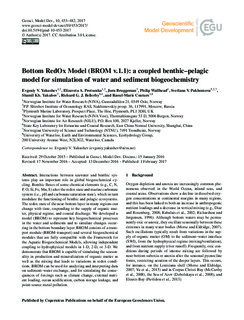Bottom RedOx Model (BROM v.1.1): a coupled benthic–pelagic model for simulation of water and sediment biogeochemistry
| dc.contributor.author | Yakushev, Evgeny | |
| dc.contributor.author | Protsenko, Elizaveta | |
| dc.contributor.author | Bruggeman, Jorn | |
| dc.contributor.author | Wallhead, Philip | |
| dc.contributor.author | Pakhomova, Svetlana V. | |
| dc.contributor.author | Yakubov, Shamil Kh. | |
| dc.contributor.author | Bellerby, Richard | |
| dc.contributor.author | Couture, Raoul-Marie | |
| dc.date.accessioned | 2018-01-09T13:21:09Z | |
| dc.date.available | 2018-01-09T13:21:09Z | |
| dc.date.created | 2017-06-02T16:18:43Z | |
| dc.date.issued | 2017 | |
| dc.identifier.citation | Geoscientific Model Development. 2017, 10 (1), 453-482. | nb_NO |
| dc.identifier.issn | 1991-959X | |
| dc.identifier.uri | http://hdl.handle.net/11250/2476451 | |
| dc.description.abstract | Interactions between seawater and benthic systems play an important role in global biogeochemical cycling. Benthic fluxes of some chemical elements (e.g., C, N, P, O, Si, Fe, Mn, S) alter the redox state and marine carbonate system (i.e., pH and carbonate saturation state), which in turn modulate the functioning of benthic and pelagic ecosystems. The redox state of the near-bottom layer in many regions can change with time, responding to the supply of organic matter, physical regime, and coastal discharge. We developed a model (BROM) to represent key biogeochemical processes in the water and sediments and to simulate changes occurring in the bottom boundary layer. BROM consists of a transport module (BROM-transport) and several biogeochemical modules that are fully compatible with the Framework for the Aquatic Biogeochemical Models, allowing independent coupling to hydrophysical models in 1-D, 2-D, or 3-D. We demonstrate that BROM is capable of simulating the seasonality in production and mineralization of organic matter as well as the mixing that leads to variations in redox conditions. BROM can be used for analyzing and interpreting data on sediment–water exchange, and for simulating the consequences of forcings such as climate change, external nutrient loading, ocean acidification, carbon storage leakage, and point-source metal pollution. | nb_NO |
| dc.language.iso | eng | nb_NO |
| dc.rights | Navngivelse 4.0 Internasjonal | * |
| dc.rights.uri | http://creativecommons.org/licenses/by/4.0/deed.no | * |
| dc.title | Bottom RedOx Model (BROM v.1.1): a coupled benthic–pelagic model for simulation of water and sediment biogeochemistry | nb_NO |
| dc.type | Journal article | nb_NO |
| dc.type | Peer reviewed | nb_NO |
| dc.description.version | publishedVersion | nb_NO |
| dc.source.pagenumber | 453-482 | nb_NO |
| dc.source.volume | 10 | nb_NO |
| dc.source.journal | Geoscientific Model Development | nb_NO |
| dc.source.issue | 1 | nb_NO |
| dc.identifier.doi | 10.5194/gmd-10-453-2017 | |
| dc.identifier.cristin | 1473894 | |
| dc.relation.project | Norges forskningsråd: 244558 | nb_NO |
| dc.description.localcode | © Author(s) 2017. This work is distributed under the Creative Commons Attribution 3.0 License. | nb_NO |
| cristin.unitcode | 194,66,0,0 | |
| cristin.unitname | Fakultet for naturvitenskap | |
| cristin.ispublished | true | |
| cristin.fulltext | original | |
| cristin.qualitycode | 2 |

